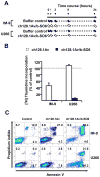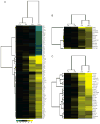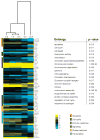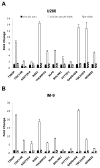Insights into the mechanism of cell death induced by saporin delivered into cancer cells by an antibody fusion protein targeting the transferrin receptor 1
- PMID: 23085102
- PMCID: PMC3513587
- DOI: 10.1016/j.tiv.2012.10.006
Insights into the mechanism of cell death induced by saporin delivered into cancer cells by an antibody fusion protein targeting the transferrin receptor 1
Abstract
We previously developed an antibody-avidin fusion protein (ch128.1Av) that targets the human transferrin receptor 1 (TfR1) and exhibits direct cytotoxicity against malignant B cells in an iron-dependent manner. ch128.1Av is also a delivery system and its conjugation with biotinylated saporin (b-SO6), a plant ribosome-inactivating toxin, results in a dramatic iron-independent cytotoxicity, both in malignant cells that are sensitive or resistant to ch128.1Av alone, in which the toxin effectively inhibits protein synthesis and triggers caspase activation. We have now found that the ch128.1Av/b-SO6 complex induces a transcriptional response consistent with oxidative stress and DNA damage, a response that is not observed with ch128.1Av alone. Furthermore, we show that the antioxidant N-acetylcysteine partially blocks saporin-induced apoptosis suggesting that oxidative stress contributes to DNA damage and ultimately saporin-induced cell death. Interestingly, the toxin was detected in nuclear extracts by immunoblotting, suggesting the possibility that saporin might induce direct DNA damage. However, confocal microscopy did not show a clear and consistent pattern of intranuclear localization. Finally, using the long-term culture-initiating cell assay we found that ch128.1Av/b-SO6 is not toxic to normal human hematopoietic stem cells suggesting that this critical cell population would be preserved in therapeutic interventions using this immunotoxin.
Copyright © 2012 Elsevier Ltd. All rights reserved.
Conflict of interest statement
The authors have no conflicts to disclose.
Figures







Similar articles
-
Conjugation of an anti transferrin receptor IgG3-avidin fusion protein with biotinylated saporin results in significant enhancement of its cytotoxicity against malignant hematopoietic cells.Mol Cancer Ther. 2007 Nov;6(11):2995-3008. doi: 10.1158/1535-7163.MCT-07-0330. Mol Cancer Ther. 2007. PMID: 18025284
-
Efficacy of an Anti-transferrin Receptor 1 Antibody Against AIDS-related Non-Hodgkin Lymphoma: A Brief Communication.J Immunother. 2015 Oct;38(8):307-10. doi: 10.1097/CJI.0000000000000092. J Immunother. 2015. PMID: 26325374 Free PMC article.
-
Inhibition of NF-kappaB and Akt pathways by an antibody-avidin fusion protein sensitizes malignant B-cells to cisplatin-induced apoptosis.Int J Oncol. 2010 May;36(5):1299-307. doi: 10.3892/ijo_00000615. Int J Oncol. 2010. PMID: 20372806 Free PMC article.
-
An antibody-based multifaceted approach targeting the human transferrin receptor for the treatment of B-cell malignancies.J Immunother. 2011 Jul-Aug;34(6):500-8. doi: 10.1097/CJI.0b013e318222ffc8. J Immunother. 2011. PMID: 21654517 Free PMC article.
-
Saporin-S6: a useful tool in cancer therapy.Toxins (Basel). 2013 Oct 7;5(10):1698-722. doi: 10.3390/toxins5101698. Toxins (Basel). 2013. PMID: 24105401 Free PMC article. Review.
Cited by
-
The TLR3 Agonist Poly Inosinic:Cytidylic Acid Significantly Augments the Therapeutic Activity of an Anti-CD7 Immunotoxin for Human T-cell Leukaemia.Biomedicines. 2019 Feb 16;7(1):13. doi: 10.3390/biomedicines7010013. Biomedicines. 2019. PMID: 30781517 Free PMC article.
-
Neurotrophic factors rescue basal forebrain cholinergic neurons and improve performance on a spatial learning test.Exp Neurol. 2013 Nov;249:178-86. doi: 10.1016/j.expneurol.2013.08.012. Epub 2013 Sep 7. Exp Neurol. 2013. PMID: 24017996 Free PMC article.
-
Riproximin modulates multiple signaling cascades leading to cytostatic and apoptotic effects in human breast cancer cells.J Cancer Res Clin Oncol. 2016 Jan;142(1):135-47. doi: 10.1007/s00432-015-2013-3. Epub 2015 Jul 12. J Cancer Res Clin Oncol. 2016. PMID: 26163990 Free PMC article.
-
Identification of Tumor Antigen AF20 as Glycosylated Transferrin Receptor 1 in Complex with Heat Shock Protein 90 and/or Transporting ATPase.PLoS One. 2016 Nov 1;11(11):e0165227. doi: 10.1371/journal.pone.0165227. eCollection 2016. PLoS One. 2016. PMID: 27802297 Free PMC article.
-
Efficacy and Mechanism of Antitumor Activity of an Antibody Targeting Transferrin Receptor 1 in Mouse Models of Human Multiple Myeloma.J Immunol. 2018 May 15;200(10):3485-3494. doi: 10.4049/jimmunol.1700787. Epub 2018 Apr 13. J Immunol. 2018. PMID: 29654211 Free PMC article.
References
-
- Aravind L, Koonin EV. THUMP-a predicted RNA-binding domain shared by 4-thiouridine, pseudouridine synthases and RNA methylases. Trends Biochem Sci. 2001;26:215–217. - PubMed
-
- Bagga S, Seth D, Batra JK. The cytotoxic activity of ribosome-inactivating protein saporin-6 is attributed to its rRNA N-glycosidase and internucleosomal DNA fragmentation activities. J Biol Chem. 2003;278:4813–4820. - PubMed
-
- Bashey A, Perez WS, Zhang MJ, Anderson KC, Ballen K, Berenson JR, To LB, Fonseca R, Freytes CO, Gale RP, Gibson J, Giralt SA, Kyle RA, Lazarus HM, Maharaj D, McCarthy PL, Milone GA, Nimer S, Pavlovsky S, Reece DE, Schiller G, Vesole DH, Hari P. Comparison of twin and autologous transplants for multiple myeloma. Biol Blood Marrow Transplant. 2008;14:1118–1124. - PMC - PubMed
-
- Beaulieu E, Ngo D, Santos L, Yang YH, Smith M, Jorgensen C, Escriou V, Scherman D, Courties G, Apparailly F, Morand EF. Glucocorticoid-induced leucine zipper is an endogenous antiinflammatory mediator in arthritis. Arthritis Rheum. 2010;62:2651–2661. - PubMed
Publication types
MeSH terms
Substances
Grants and funding
LinkOut - more resources
Full Text Sources
Other Literature Sources
Molecular Biology Databases

